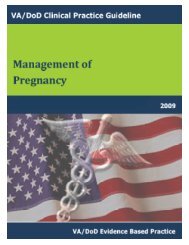DM Full Guideline (2010) - VA/DoD Clinical Practice Guidelines Home
DM Full Guideline (2010) - VA/DoD Clinical Practice Guidelines Home
DM Full Guideline (2010) - VA/DoD Clinical Practice Guidelines Home
Create successful ePaper yourself
Turn your PDF publications into a flip-book with our unique Google optimized e-Paper software.
Version 4.0<br />
<strong>VA</strong>/<strong>DoD</strong> <strong>Clinical</strong> <strong>Practice</strong> <strong>Guideline</strong><br />
for the Management of Diabetes Mellitus<br />
The study included 3,700 persons with type 1 and type 2 <strong>DM</strong> and with diabetic retinopathy. In this study, those<br />
patients with type 2 <strong>DM</strong> randomized to receive a 650 mg dose of aspirin per day, had no significant improvement in<br />
cardiovascular outcomes. In considering this result, however, the issue of generalizability arose. This group of<br />
patients with diabetes with retinopathy may have represented a population with more severe diabetes that perhaps<br />
puts them at higher risk of cardiovascular complications. Because of the insufficient power of this study, the lack of<br />
demonstrated benefit of antiplatelet therapy in this group should be taken as only a tentative suggestion that such<br />
therapy may not be useful as a routine practice among persons with type 2 <strong>DM</strong>.<br />
Sacco et al. (2003) concluded that “low dose aspirin might be less effective in patients with <strong>DM</strong> as compared with<br />
the general population” in primary prevention of cardiovascular events. The study was suggested as inconclusive<br />
due to low statistical power. Ogawa et al. (2008) examined the efficacy of low dose aspirin for primary prevention<br />
of atherosclerotic events in Japanese patients with type 2 diabetes. There was no statistical difference in<br />
atherosclerotic events in the patients treated with low dose aspirin. However, there was a statistical difference in a<br />
prespecified subgroup analysis of atherosclerotic events in patients over age 65.<br />
When considering the value of antiplatelet therapy in persons with <strong>DM</strong>, the opposite question is also valid: what are<br />
the potential dangers of such therapy for persons with <strong>DM</strong>? de Gaetano (2001) reported that aspirin users<br />
experienced more bleeding episodes, but concluded that the safety profile was acceptable. Hansen et al. (2000)<br />
investigated a possible contraindication to the use of aspirin in persons with <strong>DM</strong>. They conducted a small study to<br />
determine whether the use of aspirin interfered with the classification of albumin excretion rate (AER) or monitoring<br />
of antiproteinuric treatment in such patients. They found that “treatment with 150 mg ASA daily did not have any<br />
impact on AER or glomerular filtration rate (GFR) in patients with type 1 diabetes with macroalbuminuria.” This<br />
initial evidence suggests that aspirin does not jeopardize antiproteinuric treatment monitoring in persons with <strong>DM</strong>.<br />
Ogawa et al. (2008) found no statistically significant difference in hemorrhagic stroke or gastrointestinal bleeding<br />
between the treatment and control groups. Sacco et al. (2003) did find a statistically significant increase (1.9% in<br />
aspirin group vs. 0.2% in control group) gastrointestinal bleeding in the treatment group.<br />
The findings of the studies suggest that these recommendations may be applicable for patients with type 1 <strong>DM</strong>;<br />
however, there is no evidence to support this intuitively appealing observation. Patients with type 1 <strong>DM</strong> may be<br />
individually evaluated for aspirin therapy, with consideration of both duration of disease and the presence of other<br />
cardiovascular risk factors.<br />
EVIDENCE<br />
Recommendation Sources LE QE SR<br />
1 Aspirin therapy for patients with<br />
type 2 <strong>DM</strong> and evidence of<br />
large vessel disease.<br />
Antiplatelet Trialists'<br />
Collaboration, 1994<br />
de Gaetano, 2001<br />
I Good A<br />
2 Aspirin therapy for patients with<br />
type 2 <strong>DM</strong> age ≥ 40 with and<br />
one or more other<br />
cardiovascular risk factors<br />
3 Aspirin therapy for younger<br />
patients (age 30 to 40) with<br />
type 2 <strong>DM</strong> or with type 1 <strong>DM</strong><br />
and other cardiovascular risk<br />
factors<br />
Antiplatelets Trialists'<br />
Collaboration, 1994<br />
de Gaetano, 2001<br />
EDTRS, 1992<br />
Ogawa et al., 2008<br />
Sacco et al., 2003<br />
I Fair B<br />
Working Group Consensus III Poor I<br />
LE-Level of Evidence; QE = Quality of Evidence; SR = Strength of Recommendation (see Appendix A)<br />
Module D: Core Page 22
















